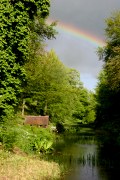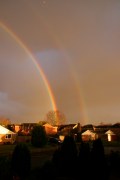 I am currently reading the most excellent “The Sun’s Heartbeat” by astronomy writer Bob Berman. It’s the kind of book I’d love to have written myself, informative, entertaining, engaging, and witty. In it, Berman explains the solar things you may always have wondered about from total eclipses (far more astounding than any partial) and sun spots to the inner sun and the secrets of rainbows. Rainbows you will remember are formed by the refraction of sunlight through water droplets in the sky, what’s more they don’t exist…without you. Every rainbow that ever there was there because someone glanced up and saw it. But, rainbows are even more strange and weird than that cynical glance might suggest. Here are Berman’s 10 things you probably didn’t know about rainbows:
I am currently reading the most excellent “The Sun’s Heartbeat” by astronomy writer Bob Berman. It’s the kind of book I’d love to have written myself, informative, entertaining, engaging, and witty. In it, Berman explains the solar things you may always have wondered about from total eclipses (far more astounding than any partial) and sun spots to the inner sun and the secrets of rainbows. Rainbows you will remember are formed by the refraction of sunlight through water droplets in the sky, what’s more they don’t exist…without you. Every rainbow that ever there was there because someone glanced up and saw it. But, rainbows are even more strange and weird than that cynical glance might suggest. Here are Berman’s 10 things you probably didn’t know about rainbows:
 1 Rainbows are seasonal, being observed late on summer afternoons and extremely rarely in winter, although they do sometimes occur all year round.
1 Rainbows are seasonal, being observed late on summer afternoons and extremely rarely in winter, although they do sometimes occur all year round.
2 You will never see a rainbow if the sun is more than half way up the sky, so you won’t catch sight of one between 9am and 4pm in early summer
3 If the sun is low, the rainbow will be brighter and the colours deeper
4 The sky above a rainbow is much darker than the sky within its arc
5 The top of a rainbow can never be higher than 42 degrees from ground level, such high rainbows seen at sunrise or sunset lack depth in the blue part
6 The ends of a rainbow stop at the ground only because that’s where the rain stops. A rainbow at a waterfall can form a full circle 82 degrees in extent
7 Double rainbows are not that rare. The second bow appears 9 degrees outside the main bow and the colours are reversed. A third bow within the first is never formed but you might see alternating green and pink fringes (non-spectral colours) known as supernmumerary arcs
8 The gap between a primary and secondary rainbow will be darker than the rest of the sky. This region is known as Alexander’s dark band, named for Alexander of Aphrodisias
9 Rainbows are like vampires, they have no reflection and cast no shadow. If you look at a rainbow in a mirror, it’s a different rainbow
10 Every rainbow is an arc, part of a circle and at the centre of the circle is no pot of gold, but something quite shocking. Think about it. The sun is directly behind you, the rainbow lies on an arc parallel to the base of a cone the apex of which is the point at which you stand. So, what’s at the centre of a rainbow? The shadow of your head, of course!
The Kindle version of Bob’s book can be found here: The Sun’s Heartbeat: And Other Stories from the Life of the Star That Powers Our Planet